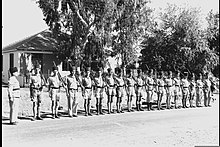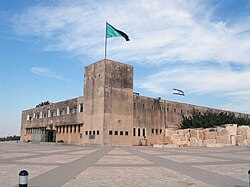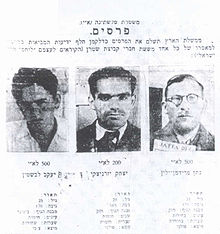
The 1948 Arab–Israeli War, also known as the First Arab–Israeli War, followed the civil war in Mandatory Palestine as the second and final stage of the 1948 Palestine war. It formally began following the end of the British Mandate for Palestine at midnight on 14 May 1948; the Israeli Declaration of Independence had been issued earlier that day, and a military coalition of Arab states entered the territory of Mandatory Palestine in the morning of 15 May.

The Emirate of Transjordan, officially known as the Amirate of Trans-Jordan, was a British protectorate established on 11 April 1921, which remained as such until achieving formal independence in 1946.

A popular uprising by Palestinian Arabs in Mandatory Palestine against the British administration of the Palestine Mandate, later known as The Great Revolt or The Great Palestinian Revolt, lasted from 1936 until 1939, demanding Arab independence and the end of the policy of open-ended Jewish immigration and land purchases with the stated goal of establishing a "Jewish National Home".
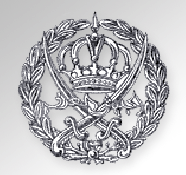
The Arab Legion was the police force, then regular army, of the Emirate of Transjordan, a British protectorate, in the early part of the 20th century, and then of the Hashemite Kingdom of Jordan, an independent state, with a final Arabization of its command taking place in 1956, when British senior officers were replaced by Jordanian ones.
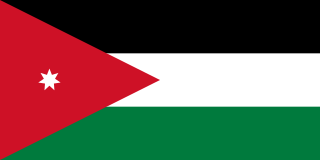
The Jordanian administration of the West Bank officially began on April 24, 1950, and ended with the decision to sever ties on July 31, 1988. The period started during the 1948 Arab-Israeli War, when Jordan occupied and subsequently annexed the portion of Mandatory Palestine that became known as the West Bank, including East Jerusalem. The territory remained under Jordanian control until it was occupied by Israel during the 1967 Six Day War and eventually Jordan renounced its claim to the territory in 1988.
Sir Herbert Layard Dowbiggin was the eighth British colonial Inspector General of Police of Ceylon from 1913 to 1937, the longest tenure of office of an Inspector General of Police (IGP). He was called the 'Father of Colonial Police'. He was knighted in 1931.
Sir Charles Augustus Tegart was an Irish police officer who served extensively in British India and Palestine.
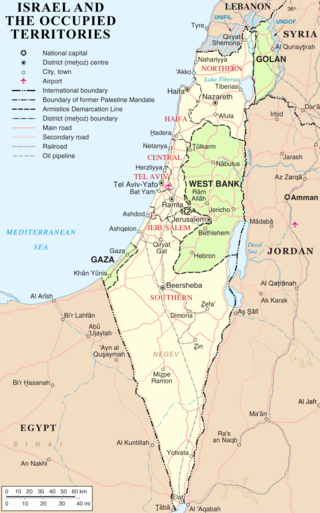
The modern borders of Israel exist as the result both of past wars and of diplomatic agreements between the State of Israel and its neighbours, as well as an effect of the agreements among colonial powers ruling in the region before Israel's creation. Only two of Israel's five total potential land borders are internationally recognized and uncontested, while the other three remain disputed; the majority of its border disputes are rooted in territorial changes that came about as a result of the 1967 Arab–Israeli War, which saw Israel occupy large swathes of territory from its rivals. Israel's two formally recognized and confirmed borders exist with Egypt and Jordan since the 1979 Egypt–Israel peace treaty and the 1994 Israel–Jordan peace treaty, while its borders with Syria, Lebanon and the Palestinian territories remain internationally defined as contested.
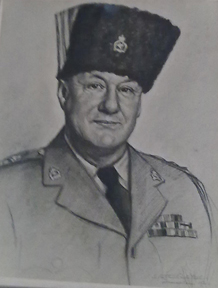
The Trans-Jordan Frontier Force was formed on 1 April 1926, to replace the disbanded British Gendarmerie. It was a creation of the British High Commissioner for Palestine whose intention was that the Force should defend Trans-Jordan's northern and southern borders. The TJFF was also an Imperial Service regiment whose Imperial Service soldiers agreed to serve wherever required and not just within the borders of their own colony, protectorate or, in the case of the Transjordan, mandate. This was in contrast to the Arab Legion, which was seen more as an internal security militia, deriving from the troops of the Arab Revolt and closely associated with the Hashemite cause. The Amir Abdullah was an Honorary Colonel of the Trans-Jordan Frontier Force from its inception. However, the local commanders thought it unnecessary to form an additional force, believing that the expansion of The Arab Legion would be a better action.

Events in the year 1936 in the British Mandate of Palestine.

Events in the year 1933 in the British Mandate of Palestine.

Events in the year 1929 in the British Mandate of Palestine.

Events in the year 1925 in the British Mandate of Palestine.

Events in the year 1921 in the British Mandate of Palestine.
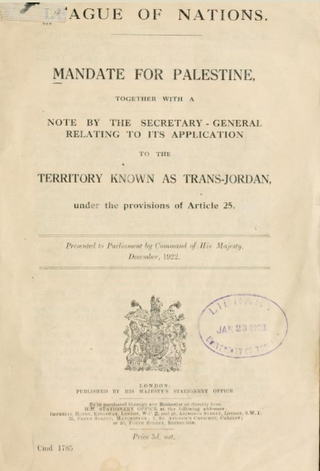
The Mandate for Palestine was a League of Nations mandate for British administration of the territories of Palestine and Transjordan, both of which had been conceded by the Ottoman Empire following the end of World War I in 1918. The mandate was assigned to Britain by the San Remo conference in April 1920, after France's concession in the 1918 Clemenceau–Lloyd George Agreement of the previously-agreed "international administration" of Palestine under the Sykes–Picot Agreement. Transjordan was added to the mandate after the Arab Kingdom in Damascus was toppled by the French in the Franco-Syrian War. Civil administration began in Palestine and Transjordan in July 1920 and April 1921, respectively, and the mandate was in force from 29 September 1923 to 15 May 1948 and to 25 May 1946 respectively.

Mandatory Palestine was a geopolitical entity that existed between 1920 and 1948 in the region of Palestine under the terms of the League of Nations Mandate for Palestine.

The All-Palestine Government was established on 22 September 1948, during the 1948 Arab–Israeli War, to govern the Egyptian-controlled territory in Gaza, which Egypt had on the same day declared as the All-Palestine Protectorate. It was confirmed by the Arab League and recognised by six of the then seven Arab League members, with Transjordan being the exception. Though it claimed jurisdiction over the whole of the former Mandatory Palestine, its effective jurisdiction was limited to the All-Palestine Protectorate, which came to be called the Gaza Strip. The President of the protectorate was Hajj Amin al-Husseini, former chairman of the Arab Higher Committee, and the Prime Minister was Ahmed Hilmi Pasha. The legislative body was the All-Palestine National Council.
This is a timeline of intercommunal conflict in Mandatory Palestine.

The 1948 Palestine war was fought in the territory of what had been, at the start of the war, British-ruled Mandatory Palestine. During the war, the British withdrew from Palestine, Zionist forces conquered territory and established the State of Israel, and over 700,000 Palestinians fled or were expelled. It was the first war of the Israeli–Palestinian conflict and the broader Arab–Israeli conflict.

The All-Palestine Protectorate, or simply All-Palestine, also known as Gaza Protectorate and the Gaza Strip, was a short-lived client state with limited recognition, corresponding to the area of the modern Gaza Strip, that was established in the area captured by the Kingdom of Egypt during the 1948 Arab-Israeli War and allowed to run as a protectorate under the All-Palestine Government. The Protectorate was declared on 22 September 1948 in Gaza City, and the All-Palestine Government was formed. The President of the Gaza-seated administration was Hajj Amin al-Husseini, the former chairman of the Arab Higher Committee, while the Prime Minister was Ahmed Hilmi Pasha. In December 1948, just three months after the declaration, the All-Palestine Government was relocated to Cairo and was never allowed to return to Gaza, making it a government in exile. With a further resolution of the Arab League to put the Gaza Strip under the official protection of Egypt in 1952, the All-Palestine Government was gradually stripped of its authority. In 1953, the government was nominally dissolved, though the Palestinian Prime Minister, Hilmi Pasha, continued to attend Arab League meetings on its behalf. In 1959, the protectorate was de jure merged into the United Arab Republic, while de facto turning Gaza into a military occupation area of Egypt.


